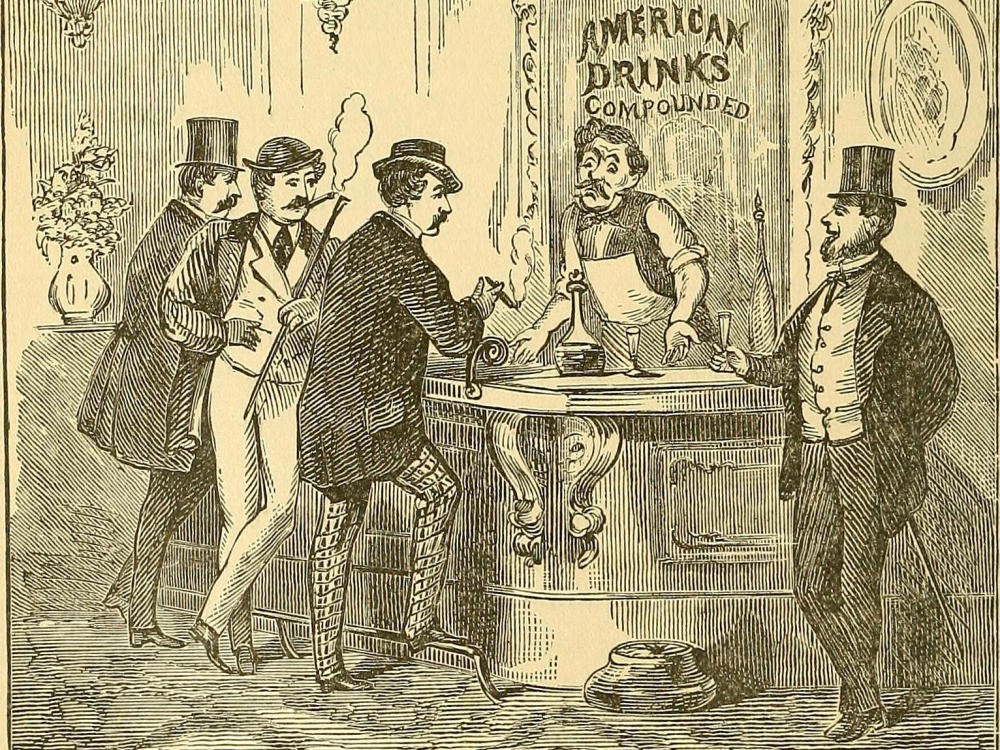Summertime is the perfect time to indulge in a refreshing cocktail on a balmy night. But before you reach for that minty mojito or sweet sangria, consider stepping out of your modern-day comfort zone and going back to the drinks of 100 years ago.
“Some of the best cocktails that we think about today — the martini, the daiquiri, the Manhattan — those all came out between the 1860s and Prohibition,” says Derek Brown, an award-winning mixologist who has studied the history of alcohol in America.
Historians have dubbed that time span the Golden Age of Cocktails, an era when bartenders got pretty inventive. Brown tells NPR’s Audie Cornish that these bar staples were originally simpler — but perhaps, better tasting— than the versions modern-day cocktail lovers are familiar with.
Take, for instance, the daiquiri.
“Most people expect to get a daiquiri when they’re going through a drive-through window in New Orleans … and it’s going to be full of grain alcohol and red coloring and things like that,” Brown says. In other words, it’s got a bad rap. But the original daiquiri, he says, “is really something so simple — it is rum, it’s lime and it’s sugar.”
American engineer Jennings Cox is credited with inventing the daiquiri while working in Cuba in the late 1890s. The story goes that he played around with Bacardi rum to get the perfect flavor, then named the drink after the small town where he worked. The original sheet of paper where he scribbled down the recipe now resides at the University of Miami library.
“Now there were plenty of people drinking rum then, and using lime and cane sugar. But it was his particular formula that became specifically the daiquiri,” Brown says.
The daiquiri stayed in Cuba until U.S. Navy Admiral Lucius Johnson discovered it. Enthralled with the cocktail, the admiral introduced it to Washington, D.C.’s Army and Navy Club in 1909. It spread like wildfire from there, eventually becoming a favorite of Ernest Hemingway and John F. Kennedy.
Another cocktail of the era, the martini, would probably be unrecognizable to barflies who order it today.
“Today you could walk into a bar and you could order a martini and you might just get warm vodka with a bunch of olives in it,” he says. “[This] masks the real character of the martini. The original martini at its invention was gin, vermouth and orange bitters.”
Bartenders — then and now — would sometimes refer to martinis made according to the original recipe as a “silver bullet” or a “crisp cocktail,” Brown says, because of its incredibly clean and fresh flavor.
The origins of the Manhattan — a cocktail species closely related to the martini — are a bit hazy.
In his book Imbibe!, liquor historian David Wondrich writes that the cocktail was probably invented at the Manhattan Club, a social organization for Democrats in New York.
Another story points to more elite origins: It suggests Lady Randolph Churchill gave birth not only to Sir Winston, but also to this cocktail — she is said to have ordered a combination of rye and vermouth for a toast during a visit to the Manhattan Club.
While we don’t know all the details, we do know that the Golden Age of Cocktails was a time when Americans learned to love mixed drinks.
The first bartenders guide was penned in 1862 by Jerry Thomas, who is considered the father of American mixology. “It really just marks this start of this incredibly creative period in making great cocktails,” Brown says.
Thomas is famous for making bartending an entertainment. His signature drink was the Blue Blazer, a cocktail he’d light on fire and pass back and forth between two glasses to create a blazing arch. (That description reminded us of this “highlight” from the Tom Cruise cinematic oeuvre.) Oh, and he’d do it all while wearing two white rats perched on his shoulders.
This sort of theatrical presentation — and the new savory blends — helped build enthusiasm for alcohol. But it was also blamed for encouraging the kind of rampant overdrinking that inspired women’s suffragists to denounce the societal ills of alcohol, and eventually led to Prohibition in 1920, Brown says.
This spring, the National Archives in Washington, D.C., kicked off Spirited Republic: Alcohol in American History, an exhibit that explores how Americans have both enjoyed — and denounced — getting tippled throughout history.
As chief spirits adviser for the archives, Brown organized a number of boozy but educational public seminars to go along with the exhibit, including a discussion of the Golden Age of Cocktails, where guests got to sample the original drinks.
If you want to mix up the historic versions of these cocktails at home, the recipes are below.
The Daiquiri
2 ounces of rum
3/4 ounce of lime juice
1/2 to 3/4 ounce of simple syrup
Shake the ingredients with ice and strain into a chilled cocktail glass.
Dry Martini
1 1/2 ounces of dry gin
1 1/2 ounces of dry vermouth
A dash of orange bitters
Lemon Peel
Stir liquors and bitters in a mixing glass with ice until very cold. Strain into a chilled cocktail glass. Squeeze the oils from lemon peel in and discard the peel.
Manhattan
2 ounces of rye whiskey
1 ounce of sweet vermouth
A dash of aromatic bitters
1 cherry
Stir liquors and bitters in a mixing glass with ice. Strain into a chilled cocktail glass. Garnish with the cherry.
9(MDA3MTA1NDEyMDEyOTkyNTU3NzQ2ZGYwZg004))
